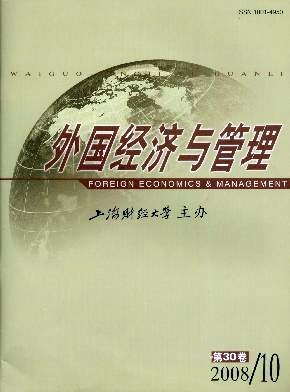试论产业关系与人力资源视角下的劳资冲突根源与解决途径
外国经济与管理 2008 年 第 30 卷第 10 期, 页码:32 - 38
摘要
参考文献
摘要
对于劳资冲突的研究,西方学术界存在着产业关系和人力资源两个学派。这两派对于冲突的根源有着不同的看法,对于冲突的解决也有着不同的实践。本文以在劳资冲突方面具有典型特征的美国为例,着重论述这两派的不同观点和实践,并指出,只有将这两派的观点和实践结合起来,才能正确而全面地把握劳资冲突的产生根源和解决途径。
[1]Kaufman,B E,and Lewin,D.Is the NLRAstill relevant totoday’s economy and workplace?[J].Labor LawJournal,1998,49:1 113-1 126.
[2]Kornhauser,A,Dubin,R,and Ross,A M.Industrial conflict[M].New York:McGraw-Hill,1954.
[3]Ulrich,D,Losey,M R,and Lake,G.Tomorrow’s HR management[M].New York:Wiley,1997.
[4]Bendix,R.Work and authority inindustry[M].New York:Wiley,1956.
[5]Jacoby,S M.Modern manors:Welfare capitalismsince the newdeal[M].Princeton,NJ:Princeton University Press,1997.
[6]Lewin,D.Workplace dispute resolution[A].in D Lewin,D J B Mitchell,and M A Zaidi(Eds.).The human resource managementhandbook,Part II[C].Greenwich,CT:JAI Press,1997:197-218.
[7]Feuille,P,and Delaney,J T.Theindividual pursuit of organizational justice:Grievance proceduresin nonunion workplaces[A].in G RFerris,andK MRowland(Eds.).Researchin personnel and human resource management[C].Greenwich,CT:JAI Press,1992,10:187-232.
[8]Dunlop,J T.Industrial relations systems[M].New York:Holt,Rinehart,and Winston,1957.
[9]Lewin,D,and Boroff,K E.The role of loyaltyin exit and voice:Aconceptual and empirical analysis[A].in D Lewin,B Kauf man,and DSockell(Eds.).Advances inindustrial and labor relations[C].Greenwich,CT:JAI Press,1996,7:69-96.
[10]Dubin,R.Constructive aspects of industrial conflict[A].in A Kornhauser,R Dubin,and A M Ross(Eds.).Industrial conflict[C].New York:McGraw-Hill,1954:37-47.
[11]Denenberg,R V,and Braverman,M.The violence-prone workplace[M].Ithaca,NY:Cornell University Press,1999.
[12]Lawler,E E,III.High-involvement management[M].San Francisco:Josey-Bass,1986.
[13]Hambrick,D C.Top management team:Key to strategic success[J].California Management Review,1987,30:88-108.
[14]Kauf man,B E,Lewin,D,and Fossum,J A.Nonunion employee involvement and participation programs:The role of employee repre-sentation and the i mpact of the NLRA[A].in B E Kauf man,and D G Taras(Eds.).Nonunion employee representation:History,con-temporary practice,and policy[C].Armonk,NY:M.E.Sharpe,2000:259-286.
[15]Zhao,Shuming.Application of human capital theory in China in the context of the knowledge economy[J].The International Journalof Human Resource Management,2008,19(5):802-817.
[16]Zhu,Cherrie,B Cooper,Hde Cieri,S B Thomson,and Shuming Zhao.Development of human resource practicesin transitional econo-mies:Evidence from China[J].The International Journal of Human Resource Management,2008,19(5):840-855.
[17]Huselid,MA.Thei mpact of human resource management practices on turnover,productivity,and corporate financial performance[J].Acade-my of Management Journal,1995,38:635-672.
[18]O’Reilly,C A,and Chat man,J.Culture as social control:Corporations,cults,and commit ment[A].in B Staw,and L L Cummings(Eds.).Researchin organizational behavior[C].Greenwich,CT:JAI Press,1996,18:263-287.
[19]赵曙明.人力资源管理研究[M].北京:中国人民大学出版社,2001.
[20]常凯,陶文忠.人力资源管理与劳动关系调整[J].中国人力资源开发,2006,(8):4-9.
[2]Kornhauser,A,Dubin,R,and Ross,A M.Industrial conflict[M].New York:McGraw-Hill,1954.
[3]Ulrich,D,Losey,M R,and Lake,G.Tomorrow’s HR management[M].New York:Wiley,1997.
[4]Bendix,R.Work and authority inindustry[M].New York:Wiley,1956.
[5]Jacoby,S M.Modern manors:Welfare capitalismsince the newdeal[M].Princeton,NJ:Princeton University Press,1997.
[6]Lewin,D.Workplace dispute resolution[A].in D Lewin,D J B Mitchell,and M A Zaidi(Eds.).The human resource managementhandbook,Part II[C].Greenwich,CT:JAI Press,1997:197-218.
[7]Feuille,P,and Delaney,J T.Theindividual pursuit of organizational justice:Grievance proceduresin nonunion workplaces[A].in G RFerris,andK MRowland(Eds.).Researchin personnel and human resource management[C].Greenwich,CT:JAI Press,1992,10:187-232.
[8]Dunlop,J T.Industrial relations systems[M].New York:Holt,Rinehart,and Winston,1957.
[9]Lewin,D,and Boroff,K E.The role of loyaltyin exit and voice:Aconceptual and empirical analysis[A].in D Lewin,B Kauf man,and DSockell(Eds.).Advances inindustrial and labor relations[C].Greenwich,CT:JAI Press,1996,7:69-96.
[10]Dubin,R.Constructive aspects of industrial conflict[A].in A Kornhauser,R Dubin,and A M Ross(Eds.).Industrial conflict[C].New York:McGraw-Hill,1954:37-47.
[11]Denenberg,R V,and Braverman,M.The violence-prone workplace[M].Ithaca,NY:Cornell University Press,1999.
[12]Lawler,E E,III.High-involvement management[M].San Francisco:Josey-Bass,1986.
[13]Hambrick,D C.Top management team:Key to strategic success[J].California Management Review,1987,30:88-108.
[14]Kauf man,B E,Lewin,D,and Fossum,J A.Nonunion employee involvement and participation programs:The role of employee repre-sentation and the i mpact of the NLRA[A].in B E Kauf man,and D G Taras(Eds.).Nonunion employee representation:History,con-temporary practice,and policy[C].Armonk,NY:M.E.Sharpe,2000:259-286.
[15]Zhao,Shuming.Application of human capital theory in China in the context of the knowledge economy[J].The International Journalof Human Resource Management,2008,19(5):802-817.
[16]Zhu,Cherrie,B Cooper,Hde Cieri,S B Thomson,and Shuming Zhao.Development of human resource practicesin transitional econo-mies:Evidence from China[J].The International Journal of Human Resource Management,2008,19(5):840-855.
[17]Huselid,MA.Thei mpact of human resource management practices on turnover,productivity,and corporate financial performance[J].Acade-my of Management Journal,1995,38:635-672.
[18]O’Reilly,C A,and Chat man,J.Culture as social control:Corporations,cults,and commit ment[A].in B Staw,and L L Cummings(Eds.).Researchin organizational behavior[C].Greenwich,CT:JAI Press,1996,18:263-287.
[19]赵曙明.人力资源管理研究[M].北京:中国人民大学出版社,2001.
[20]常凯,陶文忠.人力资源管理与劳动关系调整[J].中国人力资源开发,2006,(8):4-9.
引用本文
张子源, 赵曙明. 试论产业关系与人力资源视角下的劳资冲突根源与解决途径[J]. 外国经济与管理, 2008, 30(10): 32–38.
导出参考文献,格式为:





 6277
6277  284
284

